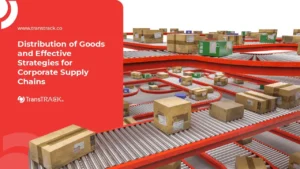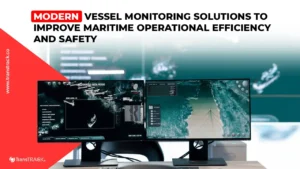Power Take Off, How Does it Work and Its Types?
Posted on May 28, 2025 by Nur Wachda Mihmidati

The power take-off (PTO) is a valuable element in providing power to secondary functions. To recognize its value requires a better understanding of this system, its various types, and how it works. Check out the following article TransTRACK for more details!
Definition of Power Take Off
Power take-off (PTO) is a widely used power generation process. It is a method of taking power from one power source and transferring it to another application. For example, PTO may consist of taking the power generated by a running engine and transmitting it to an attached tool. In other words, a Power Take-Off (PTO) is a mechanical system on an engine or vehicle that allows the transfer of power from the engine or vehicle to other equipment. It is commonly used to operate auxiliary equipment such as hydraulic pumps, air compressors, or lawn mowers. The PTO allows a machine or vehicle to provide a stable and efficient source of energy power for auxiliary equipment, making the machine or vehicle more multifunctional and useful for a variety of applications.
When we talk about PTOs, we are usually referring to a tractor power take-off. This is where the tractor engine itself generates energy that is then transferred to the attached implements. Tractors are incredible machines and are essential workhorses in almost every farm and lifestyle block throughout New Zealand. This makes them the perfect source of power for many attachments used on the land.
Primarily, tractors are used for pulling implements, which is why powered implements are often designed with PTO capabilities. PTO tractors are also excellent tools for jobs beyond towing implements, including pumping water, spraying, threshing, and more. Almost any job where a tractor’s large engine could be an ideal source of power will utilize a PTO.
From a more scientific perspective, the PTO generates transferable engine power that is reserved for implementation. This power is converted from engine rotation to mechanical rotation or hydraulic power, which has the ability to drive large equipment without using nearly as much power.
How Power Take Off Works
Have you ever heard of PTO (Power Take Off)? Trucks have various functions depending on the application. For example, a dump truck tilts the loading platform to unload cargo, and a mixer truck rotates the drum to prevent cement from hardening. In addition, many garbage trucks have the function of automatically compressing garbage. PTO is used to convert energy from the engine to the truck body to perform the operation.
PTO (Power Take Off) is one of the functions for active use of trucks. PTO is mainly installed on work vehicles such as dump trucks and mixer trucks. A power source is required for the truck to perform operations such as tilting the loading platform and rotating the drum. The PTO is a device that extracts the power for that from the engine. Normally, the engine is the necessary part for it to run, but by using the engine’s power through the PTO, it is also possible to operate the truck body without any other power source. There are some other trucks that have PTO systems, such as aerial work vehicles including tow trucks or fire trucks, and tractors or dump trucks that we may be more familiar with.
The rotating power from turning is converted into what is known as hydraulic power. This is also known as fluid power, and is controlled through a pressurized system. The twisting motion will cause a buildup of pressure in the crankshaft, and the power can be used for a variety of different purposes as it builds up.
Some of the uses we might put it to include:
- Greater engine efficiency
- Controlling hydraulics to raise or lower the garbage truck bed
- Used for towing vehicles
- Run a water pump to spray through the hose
We will see that PTOs have been used for a variety of different applications such as harvesters, wood chippers, hay balers, water pumps, and carpet cleaners.
Some types of hydraulic, pneumatic, and mechanical PTO applications include agricultural equipment such as wood chippers, harvesters, hay balers, and commercial vehicle tools such as carpet cleaning vacuum cleaners, water pumps, and mechanical arms.
Because PTOs are often exposed to the elements, handling mechanical power sources safely is critical. Operators should know how to use PTO accessories with care and always turn off and remove the key from the ignition before performing any maintenance.
Power Take Off Function
Power Take Off (PTO) is a mechanical system that allows the transmission of power from the main engine to outside equipment such as trucks, trailers, or agricultural equipment. Its function is to provide mechanical resources to equipment that requires energy to operate without the need for additional engines.
Power Take Off Function on Car
The Power Take Off (PTO) on a car is a system that allows the transmission of power from the car engine to external equipment such as a trailer, water pump, or electric generator. Its function is to utilize the car engine as a source of mechanical power without having to run an additional engine. PTO is usually used in trucks and work cars to help perform heavy tasks such as moving heavy loads or supplying electrical power in areas that do not have electrical resources.
Function of Power Take Off on Dump Truck
The Power Take Off (PTO) on a Dump Truck is a system that enables the transmission of power from the truck’s engine to the hydraulic system used to lift and lower the dump bed on the truck. Its function is to assist the truck in performing the tasks of loading and moving materials, such as soil, sand, and rock. The PTO ensures that the dump bed can work efficiently and effectively, making the tasks of loading and moving materials on the truck easier.
Power Take Off Function on Heavy Equipment
Power Take Off (PTO) on heavy equipment is a system that allows the transmission of power from the heavy equipment engine to external equipment such as hydraulic pumps or attachments. Its function is to utilize the machine engine as a mechanical power source without having to run additional machinery. PTOs are commonly used in heavy machinery such as excavators, bulldozers, and backhoes to help perform heavy tasks such as digging, moving materials, and moving materials. The PTO ensures that the attachments can work efficiently and effectively, making construction and material removal tasks easier on the machine.
Function of Power Take Off on Bus
The Power Take-Off (PTO) on a bus is a system that allows the bus to pass energy from the bus engine to another system, such as a hydraulic or electrical system. It is typically used to operate auxiliary equipment, such as hydraulic pumps, lawn mowers, or air compressors, which can be used off-road. The PTO allows the bus to provide a stable and efficient source of energy power for auxiliary equipment, making the bus more multifunctional and useful for various applications.
Types of Power Take Off
In previous years, we saw Power Take-Off operate from belt drives, pneumatics such as air out and drive shaft attachments. In most situations today, the way a PTO works is with a gear transmission. However, we still have three common PTO methods available in the mobile engine market:
- Engine crankshaft drive style
- Tractor style
- Truck transmission force
CRANKSHAFT DRIVEN METHOD
The crankshaft driven method is usually used for hydraulic pumps installed at the front of our trucks. For example, we can use it for a cement mixer. The small shaft would have a U-joint design and be attached to a yoke coupler to rotate the pump. Typically, we don’t hear this configuration referred to as a PTO, but it is still technically classified as a PTO.
TRACTOR PTO
How does the PTO work? We can trace the tractor PTO almost as far back as the tractor itself since most PTOs drive with the transmission, which is located near the rear of the tractor. This form of PTO will only activate when we engage the transmission clutch. In fact, the mechanism is paired with the transmission so that when the clutch is pressed, the PTO does not run.
PTO TRUCK TRANSMISSION STYLE
Smaller trucks use PTOs to drive hydraulic pumps for hoists or winches. Meanwhile, large trucks may use PTOs for various purposes, but hydraulic pumps are the most common, and they are used to load and unload various types of cargo. For larger transmissions, we may have two to three of them to help with the provision of each transmission. Leave the normal clutch out for the output shaft to rotate.
Power Take Off (PTO) Applications in Industry
Power Take Off (PTO) has a very important role in various industrial sectors, especially for transferring power from the main engine to auxiliary equipment. Here are some of the main applications of PTOs in various sectors:
Agricultural Sector
PTOs are very commonly used in the agricultural sector, where tractors and other agricultural machinery utilize PTOs to drive implements.
- Use on Tractors: The PTO allows the tractor to drive equipment such as mowers, rotary plows, sprayers, and hay balers.
- Work Efficiency: With PTO, farmers can operate various implements using only the power source of one machine, reducing the need for many independent machines.
Transportation Sector
In the world of transportation, especially in heavy vehicles, PTOs are used to operate auxiliary equipment.
- Fire Fighting Vehicles: The PTO is used to drive the water pump on the fire truck, ensuring high water pressure for fire fighting.
- Garbage Truck: The PTO drives the lifting mechanism and compressor on the garbage transportation vehicle.
- Tank Truck: The PTO helps operate pumps to move liquids such as fuel or water.
Construction Sector
In the construction sector, PTOs support heavy equipment operations that require additional power.
- Cranes and winches: The PTO drives a winch or cable used to lift heavy materials.
- Concrete Mixer: The PTO is used to rotate the concrete mixing drum on the mixer truck, keeping the mixture homogeneous during travel.
- Dump Truck: The PTO supports the hydraulic mechanism to lift the tailgate so that the load can be unloaded easily.
Forestry Sector
In the forestry industry, PTOs are used to drive heavy equipment such as:
- Wood Chipper: A wood chipper utilizes the PTO to turn logs into chips.
- Forestry Winch: Used to pull large logs from hard-to-reach areas.
Marine Sector
In the marine sector, PTOs are used on ships to support specific operations.
- Water Pump: The PTO on the ship helps operate the pump for water discharge or water supply.
- Electrical Generator: In some cases, the PTO is used to drive a generator for electrical power needs on board.
Application of PTO in Commercial Vehicles in Various Industries
In the world of commercial vehicles, efficiency and multifunctionality are important aspects that continue to be developed to support operations in the field. One technology that has a big role in this is PTO (Power Take-Off). This system allows vehicles to take power directly from the engine to operate various auxiliary devices, without the need to use a separate engine.
PTOs are widely used in various industrial sectors due to their flexibility in delivering power to various work aids. From construction to logistics to agriculture-each sector has specific needs that can be supported with the application of this technology.
Here are examples of PTO applications in three key industries:
1. Construction Industry
PTO Application:
- Concrete Mixer Truck: To rotate the concrete mixer drum.
- Dump Truck (Tipper Truck): Lifting the tailgate using a hydraulic system.
- Mobile Crane: Provides power to crane systems and other lifting aids.
Benefits:
- Speeds up and simplifies project work in the field.
- Reduces the need for additional heavy equipment.
- Improve work efficiency and safety.
2. Logistics Industry
PTO Application:
- Refrigerated Truck: Operate the refrigeration system without external electricity.
- Tail Lift (Hydraulic Lift): Facilitates the loading and unloading process of heavy goods.
- Truck-Mounted Crane or Forklift: Used for loading and unloading purposes in locations without infrastructure.
Benefits:
- Maintain product quality in shipping.
- Optimize the process of distribution and handling of goods.
- Reduce labor time and dependency on external tools.
3. Agriculture Industry
PTO Application:
- Tractor: Delivering power to various farm implements such as rotavators, water pumps, and harvesters.
- Tank Sprayer & Manure Spreader: To spray liquid fertilizer or pesticide evenly.
- Grain Auger and Conveyor: For transferring crops to storage.
Benefits:
- Speeds up the cultivation and harvesting process.
- Supports large-scale agricultural mechanization.
- Saving power and operating costs.
PTOs are becoming a crucial element in modern commercial vehicles, offering efficient and flexible power solutions for a wide range of industrial needs. With a single source of power from the vehicle engine, a wide range of auxiliary functions can be carried out effectively, supporting productivity and efficiency in every sector.
What are the main components in the PTO system?
Here are the main components of the PTO (Power Take-Off) system and their respective functions:
1. Gearbox (PTO Gearbox)
- Function:
Converts and transmits power from the main engine to the auxiliary devices. The gearbox regulates the speed and torque required by the driven tool. - Type:
Either direct mount (attached directly to the transmission) or remote mount (connected through the driveshaft).
2. Clutch / PTO Connector
- Function:
Controls the linkage between the engine and the PTO system. This clutch allows the operator to turn the power flow to the attachment on or off without shutting down the engine. - Type:
Can be manual (mechanically engaged) or automatic (using hydraulic or electronic systems).
3. Driveshaft
- Function:
Transferring mechanical power from the PTO to a work device or tool located in a position separate from the vehicle engine. - Notes:
Generally used in remote type PTO systems or if the driving device is far away from the PTO point.
4. Mounting Bracket
- Function:
Provides a secure and stable mounting place for the PTO unit on the transmission or vehicle chassis. - Importance:
Strong and proper support is essential to avoid excessive vibration and mechanical damage.
Additional Components (Optional):
- Hydraulic Pump / Compressor: PTO-driven device, depending on the application-e.g. hydraulic pump for dump trucks or compressor for refrigeration trucks.
- Control Unit/Switch:
Switch or control panel for manually or automatically activating or deactivating the PTO system. - Cooling System (if required):
To cool the PTO gearbox in heavy load or long operation applications.
Common Power Take Off (PTO) Problems and Solutions
Some common problems with PTO systems can disrupt operations, decrease efficiency, and even cause complete equipment failure. Understanding the causes and solutions is an important step to maintaining the performance and longevity of these systems.
Here are some of the common problems that occur with PTO systems, along with their solutions:
1. PTO Oil Leak
Common Causes:
- Seal or gasket wear and cracking
- Loose bolts or imprecise mounting
- Uneven or damaged mounting surface
- Excessive internal pressure due to blocked vents
Solution:
- Replace leaking seals/gaskets
- Tighten all bolts to standard
- Make sure the mounting surface is flat and clean
- Check and clean the PTO vent
2. PTO Overheating
Common Causes:
- Inappropriate or insufficient lubricating oil
- Workload exceeds capacity
- Long duration non-stop operation
- No additional cooling system
Solution:
- Use quality and specification oil
- Limit workload according to manufacturer’s recommendations
- Add a cooling system if required
- Give the tool a rest period in long work cycles
3. PTO Noise
Common Causes:
- Gear or bearing wear
- Misalignment between PTO and transmission
- Lack of lubricant
- Loose bolts or brackets
Solution:
- Replace worn gears/bearings
- Check alignment and reinstall if necessary
- Ensure that the lubrication system is running normally
- Check mounting tightness regularly
Despite being a robust and flexible system, the PTO still requires regular maintenance and proper operation. By understanding the symptoms of damage early on and taking appropriate corrective action, companies can avoid downtime, save repair costs, and maintain the smooth operation of commercial vehicles in various industrial sectors.
Power take-offs play an important role in enabling the transfer of power from the prime mover to secondary or drive components without the need for additional separate machinery. Different types of PTOs serve many applications, ranging from small-scale operations to large industrial and construction projects. Choosing the right PTO for a particular application is essential for proper performance of the driven component.

That’s what we can briefly learn about power take off. You can learn other things through the TransTRACK blog as well. If you are also interested in installing fleet management system on your fleet, then you can use TransTRACK’s FMS which has many advantages. Find out the advantages through the TransTRACK.ID website!
Recent Post
Topic :
Recommended Articles

 Bahasa Indonesia
Bahasa Indonesia







